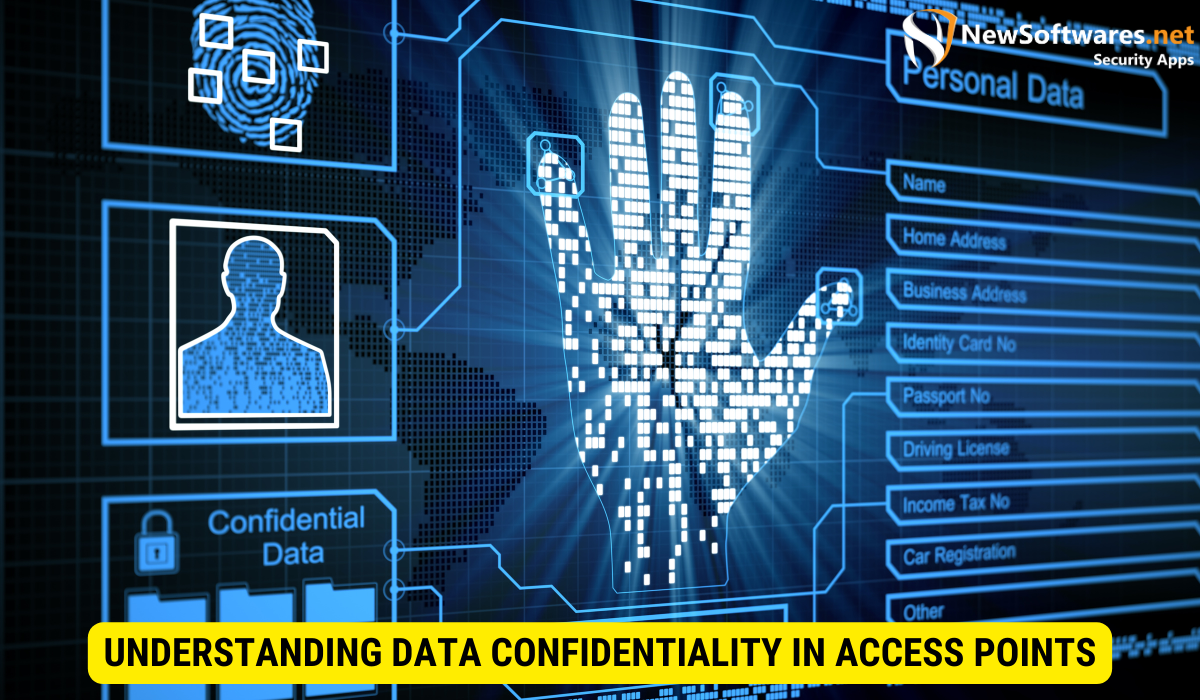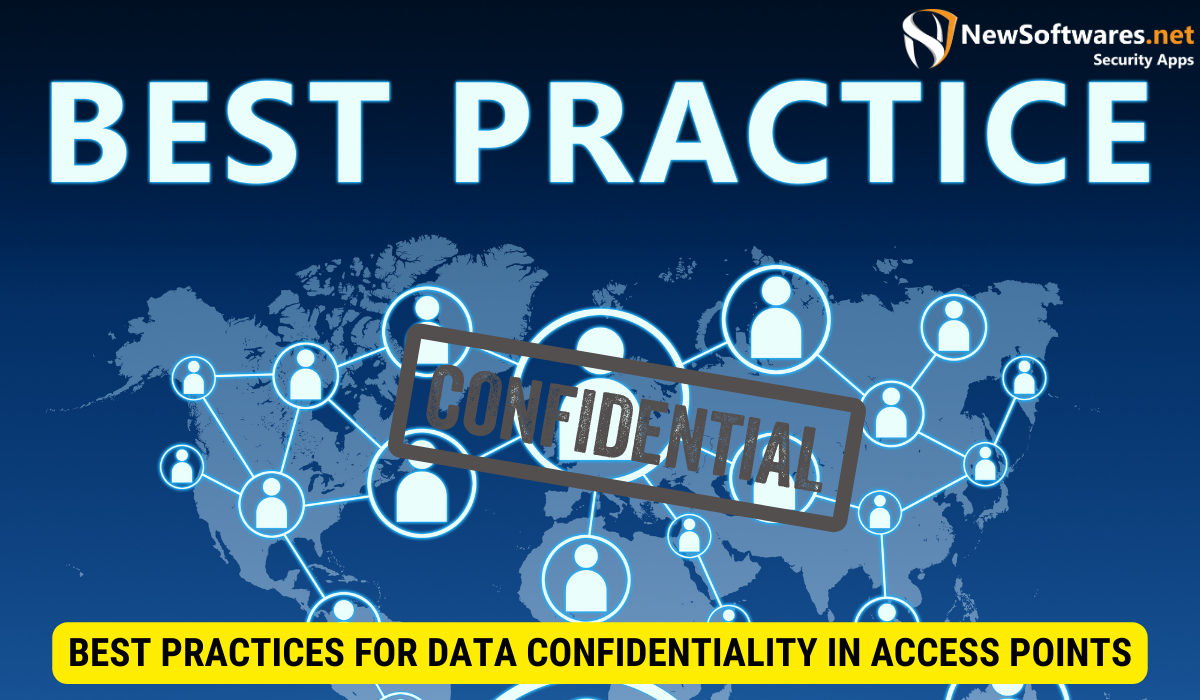Explore how access points secure wireless networks by encrypting data frames and setting the privacy bit for comprehensive data confidentiality.
Data confidentiality is a crucial aspect of securing wireless networks. Access points play a vital role in maintaining this confidentiality by ensuring that all data frames are protected and have the privacy bit set. Understanding the significance of data confidentiality in access points, the role of data frames, the privacy bit, and the interplay between these elements is essential for establishing a secure network environment. Together, we will explore these topics in detail and present best practices for ensuring data confidentiality in access points.
Understanding Data Confidentiality in Access Points

Data confidentiality is the practice of ensuring that sensitive information transmitted over a network remains secure and cannot be accessed by unauthorized individuals. Access points, as the central hubs of wireless networks, are responsible for safeguarding data confidentiality. They need to establish a secure connection and protect the transmitted data frames.
When it comes to wireless networks, data confidentiality is of utmost importance. The proliferation of wireless technology has made it easier for hackers and malicious individuals to intercept sensitive information. This includes personal data, financial details, and corporate secrets. The consequences of unauthorized access to this data can be severe, ranging from identity theft and financial losses to the compromise of valuable intellectual property. It is therefore crucial for access points to play a pivotal role in maintaining the integrity of wireless networks by ensuring data confidentiality.
The Importance of Data Confidentiality
Data confidentiality is crucial in wireless networks to protect sensitive information such as personal data, financial details, and corporate secrets. Unauthorized access to this data can lead to identity theft, financial losses, or compromise of intellectual property. By ensuring data confidentiality, access points play a pivotal role in maintaining the integrity of wireless networks.
Access points act as gatekeepers, ensuring that only authorized individuals can access the network and its resources. They establish a secure connection between the user’s device and the network, encrypting the data frames to make them unreadable to unauthorized users. This encryption process is essential in preventing the interception and deciphering of sensitive information.
How Access Points Maintain Confidentiality
Access points employ multiple measures to maintain data confidentiality. Firstly, they use encryption protocols such as Wi-Fi Protected Access (WPA) and WPA2 to transform the data frames into an unreadable format. These encryption algorithms, like Advanced Encryption Standard (AES), ensure that even if an unauthorized user intercepts the data, they cannot decipher its contents.
In addition to encryption, access points use authentication mechanisms to ensure that only authorized users can access the network. These mechanisms include key-based authentication and credentials verification. By requiring users to provide valid credentials or passcodes, access points prevent unauthorized individuals from gaining access to the network and its sensitive data.
Furthermore, access points often provide network segmentation, creating separate virtual networks (VLANs) to isolate different types of traffic and prevent unauthorized access to sensitive data. This segmentation enhances data confidentiality by limiting the potential attack surface and minimizing the risk of unauthorized access.
Another important aspect of maintaining data confidentiality is regular security updates and patches. Access points need to stay up to date with the latest security measures to protect against emerging threats and vulnerabilities. By regularly updating their firmware and software, access points can ensure that they are equipped with the necessary defenses to maintain data confidentiality.
Overall, access points play a critical role in maintaining data confidentiality in wireless networks. Through encryption, authentication mechanisms, network segmentation, and regular security updates, access points ensure that sensitive information remains secure and inaccessible to unauthorized individuals. By implementing these measures, access points contribute to the overall security and integrity of wireless networks, providing users with peace of mind when transmitting sensitive data.
The Role of Data Frames in Access Points
Data frames are packets of information that are used to transmit data over a wireless network. In the context of access points, data frames play a critical role in maintaining data confidentiality.
Defining Data Frames
Data frames are structured packets that include a header, payload, and trailer. The header contains essential information such as the source and destination addresses, while the payload contains the actual data being transmitted. The trailer includes error detection codes to ensure data integrity.
Let’s take a closer look at each component of a data frame:
- Header: The header of a data frame contains crucial information that helps in the proper routing and delivery of the transmitted data. It includes the source and destination addresses, which allow the access points to determine where the data is coming from and where it needs to be sent. This information is vital for establishing a successful communication link between devices.
- Payload: The payload is the actual data being transmitted. It can include various types of information, such as text, images, audio, or video. The payload is what the recipient device receives and processes to extract the intended message or content. It is the core component of a data frame and holds the valuable information that needs to be transmitted securely.
- Trailer: The trailer of a data frame contains error detection codes, such as checksums or cyclic redundancy checks (CRCs). These codes are used to verify the integrity of the transmitted data. By performing calculations on the received data and comparing the results with the codes in the trailer, the access points can detect if any errors occurred during transmission. This ensures that the data received is accurate and reliable.
The Connection Between Data Frames and Confidentiality
Access points ensure data confidentiality by encrypting the payload of data frames using encryption algorithms discussed earlier. This encryption prevents unauthorized individuals from intercepting and deciphering the transmitted data.
Encryption is a process of converting plaintext data into ciphertext, which is unreadable without the corresponding decryption key. By encrypting the payload of data frames, access points make it extremely difficult for eavesdroppers to understand the content of the transmitted data, even if they manage to intercept it.
Data frames also include control information such as the privacy bit, which indicates whether the frame requires data confidentiality. By having the privacy bit set, access points can identify which frames must undergo encryption. This allows access points to selectively encrypt sensitive data, optimizing the use of computational resources and reducing the processing overhead.
Ensuring data confidentiality is crucial in wireless networks, especially in environments where sensitive information is being transmitted. By leveraging data frames and encryption techniques, access points can provide a secure and private communication channel for users, protecting their data from unauthorized access and ensuring the integrity of the transmitted information.
The Privacy Bit in Access Points
The privacy bit is a crucial component in maintaining data confidentiality in access points. It serves as an indicator for the access point to enable encryption for specific data frames.
What is the Privacy Bit?
The privacy bit is a single bit within the data frame’s header that determines whether the frame requires encryption or not. When the privacy bit is set, the access point knows that the frame must undergo encryption to maintain data confidentiality.
Setting the Privacy Bit for Enhanced Security
To enhance security, access points are typically configured to enforce encryption for all data frames by default. Setting the privacy bit ensures that every frame transmitted by the access point is encrypted, regardless of the specific needs of the connected devices.
By enforcing encryption for all data frames, access points provide an additional layer of data confidentiality, protecting sensitive information from potential eavesdroppers or unauthorized users.
The Interplay of Confidentiality, Data Frames, and Privacy Bit
The combination of data confidentiality, data frames, and the privacy bit establishes a robust security framework for wireless networks.
Ensuring Confidentiality Through Data Frames and Privacy Bit
Access points ensure data confidentiality by encrypting the payload of the data frames. The privacy bit is used by the access point to identify the frames that require encryption. By encrypting the frames with the privacy bit set, access points protect the transmitted data from unauthorized access, maintaining confidentiality throughout the wireless network.
Potential Risks Without Proper Privacy Settings
Failure to properly set the privacy bit or enforce encryption for all data frames can expose the network to potential risks. Without encryption, unauthorized individuals can intercept and access sensitive information, compromising data confidentiality. It is crucial to configure access points correctly to minimize such risks.
Best Practices for Data Confidentiality in Access Points

To ensure optimal data confidentiality in access points, the following best practices should be considered:
Regularly Updating Access Point Settings
Access points should be kept up to date with the latest firmware and security patches. Regularly updating access point settings ensures that any known vulnerabilities are addressed and that the security measures are current and effective.
Understanding and Utilizing Privacy Settings
Access point administrators should have a deep understanding of the available privacy settings and encryption protocols. By correctly configuring these settings, access points can provide comprehensive data confidentiality.
Key Takeaways
- Data confidentiality in access points is crucial for securing wireless networks and preventing unauthorized access to sensitive information.
- Access points maintain data confidentiality through encryption protocols, authentication mechanisms, and network segmentation.
- Data frames are structured packets used to transmit data over a wireless network.
- The privacy bit within data frames enables access points to identify frames that require encryption.
- Enforcing encryption for all data frames by setting the privacy bit enhances data confidentiality in access points.
- Regularly updating access point settings and understanding privacy settings are essential best practices for maintaining data confidentiality.
FAQs
Q: What is the privacy bit in access points?
A: The privacy bit is a single bit within the data frame’s header that determines whether the frame requires encryption. It serves as an indicator for the access point to enable encryption for specific data frames.
Q: How do access points ensure data confidentiality?
A: Access points ensure data confidentiality by implementing encryption protocols, such as WPA and WPA2, and using authentication mechanisms to establish secure connections. They also segment networks to isolate different types of traffic and prevent unauthorized access to sensitive data.
Q: Why is data confidentiality important in wireless networks?
A: Data confidentiality is vital in wireless networks to protect sensitive information from unauthorized access. Without data confidentiality, personal data, financial details, and intellectual property may be compromised, leading to identity theft, financial losses, or other detrimental consequences.
Q: Can access points be configured to enforce encryption for all data frames?
A: Yes, access points can be configured to enforce encryption for all data frames by setting the privacy bit accordingly. This ensures that every frame transmitted by the access point undergoes encryption, regardless of the specific needs of the connected devices.
Conclusion
In conclusion, access points play a crucial role in ensuring data confidentiality for all data frames in wireless networks. By understanding the importance of data confidentiality, the role of data frames, the privacy bit, and their interplay, network administrators can establish a secure environment. Adhering to best practices, such as regularly updating access point settings and utilizing privacy settings effectively, is vital for maintaining data confidentiality and safeguarding sensitive information.
